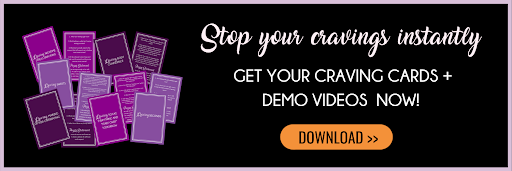I bet you have things in your life that really matter to you. Things like pursuing your passions, learning new things, seeing the world, spending time with those you love. So do I. Everybody wants to live their best life now, right?
So here’s a question for you. Are you putting a majority your focus, time and energy toward actually building the life you say you want?
Ten years ago I would’ve loved to have said YES to that. But it would’ve been a lie.
Back then I spent 90% of my energy on something far less fulfilling.
Instead of focusing on my passions, I lived in an ongoing mental drama of food-focused thoughts.
And I don’t mean blissful fantasies like enjoying bonbons and champagne by the pool, either. It was pretty much the opposite of that.
I obsessed 24/7 about what I ate yesterday, what I was going to eat today, and how much weight it would make me gain. I plotted. I planned. And lost hours, days, and weeks to guilt-ridden, food-obsessed thinking.
Worst of all, my mental and emotional batteries were drained. I had no energy left for the things I truly wanted in life. All because I couldn’t stop fixating on my next meal.
Now I’m thrilled to say that food doesn’t cross my mind much–unless, of course, I’m hungry! Food is my ally in creating the life that I love, not something that I obsess about in every waking moment.
How did I stop the food-focused self-talk and take back my mental energy for better things?
Here’s a hint–controlling your thoughts is not the answer. There is a better way.
Ready to stop the fanatical food self-talk and give that mental energy to something better? Let’s make sure that having food on the brain doesn’t get in the way of living your best life ever again!
–
–
Step One: Know your brain (and how it works). I bet that at some point, you’ve heard advice about how to stop food obsessed thoughts. I’m willing to bet that most of it boiled down to “just stop thinking about food.”
Easy to say. Nearly impossible to do.
What if I told you right now to NOT think about bread? What if I insisted that you think about anything BUT bread for the rest of the day? What do you think would happen next?
Bread would consume all of your thoughts, whether you wanted to think about it or not.
That’s one of the quirks about your brain. It doesn’t understand the negative very well. When you say “don’t think about bread,” all it picks up is the “bread” part. And it just keeps thinking about it…and thinking about it.
That’s the bad news. The good news, though, is that you can turn the tables on your brain. Instead of focusing on what you don’t want, shift to what you DO want!
For example, instead of telling yourself what you can’t eat, look at it another way. Ask yourself what you could have right now that would energize, support, and satisfy you the most.
It takes a little practice. But the more you shift your focus from NO to YES, the easier it becomes. So make it a habit to start accentuating the positive in your life, one thought at a time.
Step Two: STOP Stressing about what you’re eating.
It’s tough to stop thinking about food when you’re plotting, planning, and calculating the macronutrient values of everything you eat. I get it.
Funny thing, but this is just what diets make you do.
By their nature, diets encourage you to focus on food. Pretty soon, all you’re thinking about is whether something you want to eat is OK according to whatever diet guru you’re following.
No matter how healthy a diet seems, diets are about restriction. Whether it’s cutting carbs, going keto, or starting paleo, they’re still diets. They restrict something.
And restrictive diets lead to unrestricted food thoughts. That’s why the dropping the diet is so powerful!
So for your own better mental health, stop following someone else’s eating plan. This alone will bring your mental food-stress level down to almost zero.
Step Three: Keep your body happy (and nourished). We’ve talked about this before here on the blog (and on the YouTube channel), but it bears repeating.
Your body needs nourishment. When you support your body with adequate fuel, it’ll support you back. This leads to all kinds of beautiful things!
For one thing, your brain won’t be stuck into survival mode, flying into mental food overdrive and prompting you to eat.
Even better, over time your brain will learn to trust that you’ll properly feed your body. It’ll know that it doesn’t have to send out SOS hunger pangs to ensure its survival.
This will calm those fearful food thoughts down big-time!
Step Four: Mix it up at the table! Once you drop the food rules, replace them with food freedom. By that, I mean giving yourself the option to choose from a variety of foods to support and energize your body.
That means adding back in the carbs, the fruit, or whatever you cut for the latest fad diet!
You see, your body has a wisdom of its own. If it’s missing something it needs, it’ll do what it takes to get it. That includes triggering frenzied thoughts about the foods that hold the nutrients that it needs.
Those scarcity pangs can make you feel like a food-crazed monster with uncontrolled cravings, and they can be a little scary at times. But they might just mean that you simply need more nutrition coverage in your diet!
But if you eat a wide array of foods in the first place, you’ll start preempting those wild cravings. That will significantly cut down on anxiety-ridden food thoughts and reduce your food stress.
Step Five: Choose foods that light you up and warm your belly. There’s eating to survive. Then there’s eating to feel supported, energized, and satisfied. I’m talking about that warm-bellied feeling that you get when it’s a “Goldilocks” kind of meal.
That is, just right.
We’re talking about leaving the table feeling full in the best way possible!
Don’t believe it when Cosmopolitan magazine calls five almonds and an apple a “meal.” Sure, it’s a nice little snack. But I defy anyone to prove to me that this is a satisfying meal.
If you try to trick yourself into believing that a cube of cheese is a healthy lunch, just know that your body won’t buy it for long. Eventually, it’ll strike back and turn up the volume on cravings.
Which, of course, leaves your brain focused on one thing–food.
So be sure that when you leave the table, make sure it’s a full meal that makes you feel grateful and satisfied.
Step Six: Consider the non-food causes for food-focused thoughts. Taking care of your body’s needs eliminates a lot of mental food stress. But there is one more factor that I need to share, the thing that solidifies those food thoughts on a repeating loop in your head.
It’s the stress and anxiety that food-focused thoughts create. I mean root causes of the food-focused thoughts that have nothing to do with the food itself.
There are root causes for food-focused thoughts that might be hiding just under the surface. These underlying causes tend to trigger emotions, which in turn create habitual responses.
And here’s the kicker–those habitual responses might be so well ingrained that you don’t even notice them.
What am I talking about here? Let me share an example…
We all have worries in our lives. That’s part of being human. But one of the easier ways to distract ourselves from emotional or mental stress is by grabbing a snack. (We’ve all done it from time to time!)
But if that response happens on the regular, it can morph into a habitual pattern. And that pattern eventually does two things that keep you stuck…
First, it creates automated responses that drive you to think about food.
Second, it sabotages your chances of healing the real issue behind the food-focused thought. It triggers you to rely on food to solve a problem that it simply cannot solve.
That’s kind of a big deal, isn’t it?
Many of us aren’t aware of this side of the coin. Some of us choose to ignore it. But it’s a powerful thing–and it needs to be addressed if you truly wish to drop food-obsessed thoughts for good.
But here’s the cool part: if you’re willing to do this deeper work, it’ll give you the edge that will make this transformation last a lifetime!
Now, I bet that you’re wondering one thing–how do I make this happen in the real world? If you’ve had food on the brain for most of your life, this might sound like just a bunch of good ideas, but not something that’ll work for you.
Trust me, I get it.
I’ve been there, felt stuck, and believed that I’d be the star of a food-obsessed reality show for the rest of my life.
But I found a way to stop the madness, take back my power, and put my energy toward my best life instead of my next meal. It was a life-changing miracle discovery, and I want to share it with you.
Click the image below where I’ve got a special gift for you! We call them, “Craving Cards”, and they’re one of our most popular tools!
If you ever feel night time cravings, sugar cravings, the urge to just say “screw it I’m going to start my diet over tomorrow”, or like you need a little body confidence pick me up…
Just grab a card, go through the prompts, and shift it instantly!
Click the image above and let me know where to send them!
You’ll also get mini demo video training sessions for each card where I share how to use the cards and some of my best tips for food freedom forever!
With our Craving Cards and Demo Series…
You’ll learn how to stop cravings in their tracks, feel confident, and get back your power, fast!
Love,
Brittany
PS: Want the exact freedom and ease with our foods that myself and thousands of our clients get to experience?
In our Beating Binge Eating Blueprint (BBEB), I show you how to make this happen in just 8 weeks!
Many of our students have seen a DRASTIC difference in as little as a few days!
It’s our signature program, and up until recently, it was $3000 or more to join.
For now, you can get it as a part of our Food Freedom Collection for practically free by clicking the image below!
There is no catch…every resource I’ve created for food freedom and body confidence will land straight in your if you just click that image below and let me know where to send it!





